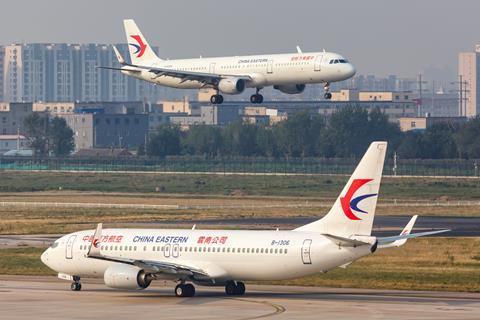China’s three largest carriers grew their domestic networks in October, tapping into second- and third-tier cities to launch new routes, as they recorded yet another month of domestic traffic recovery.
The ‘Big Three’ — Air China, China Eastern Airlines and China Southern Airlines — each launched more than 10 new domestic routes during the month.

Among them, China Southern, which returned to profitability in its third-quarter earnings, rolled out the most number of new destinations, launching 18 routes. Air China announced 17 new routes, while China Eastern launched 12 routes.
Some of the newly-launched routes were between smaller Chinese cities, such as Air China’s daily flights from Wenzhou in eastern China to Nanning in the south. Others included flights from the carriers’ hubs to smaller regional points, like China Eastern’s flights between its Shanghai Hongqiao hub to Wuzhou in southern China.
October’s route expansion is also highest number of launches in recent months, underscoring the rapid domestic recovery reported by each of the three carriers after being impacted by the coronavirus outbreak.
For the month, the ‘Big Three’ continued to see growth in domestic traffic, helped by the Golden Week national holidays at the beginning of the month. However, the carriers saw a decline in passenger load factor, as capacity growth outpaced traffic volume.
International traffic remained at dismal levels, due to global travel restrictions to prevent the spread of the pandemic.
China Southern carried 11.8 million domestic passengers in October, a 6% month-on-month increase which was also about 3.3% higher than the same month last year.
The Guangzhou-based carrier saw domestic RPKs rise 6.5% month on month, with ASKs gaining 8% compared to September, leading to a 1.15 percentage point decline in domestic load factor.
Year on year, China Southern saw domestic RPKs rise 2.6%, with ASKs climbing 11.6%.
The airline carried around 76,000 international passengers for the month, a 5.8% decrease month on month, and a 95% drop year on year.
As for Air China, it carried 8.37 million domestic passengers in the month, a 3.6% increase month on month and a 7.7% increase compared to the same month last year.
Month on month, domestic RPKs grew 8.3%, while ASKs rose 9.8%, leading to a decline in passenger load factor of 1.1 percentage points to 76.1%.
Compared to October 2019, Air China saw domestic RPKs rise 2.6%, with ASKs increasing 13.7%.
Air China carried 42,900 international passengers in October, representing a 10% month-on-month rise, but a 97% decline year on year. It was the only carrier among the ‘Big Three’ to report an increase in international traffic month on month.
Meanwhile, China Eastern carried 9.1 million domestic passengers in October, nearly 2% higher month on month. Compared to last year, it represented a 2.7% decline.
Domestic ASKs rose 3.8% month on month, with RPKs increasing 2.6%, leading to a drop of 0.4 percentage points in domestic passenger load factor.
Year on year, China Eastern reported a 0.6% increase in RPKs, with ASKs climbing 9.7%.
As for its international network, the SkyTeam carrier reported an 8.3% month-on-month fall in passenger numbers, carrying just 26,700 passengers for the month. Year on year, passenger numbers plunged 98%.


























